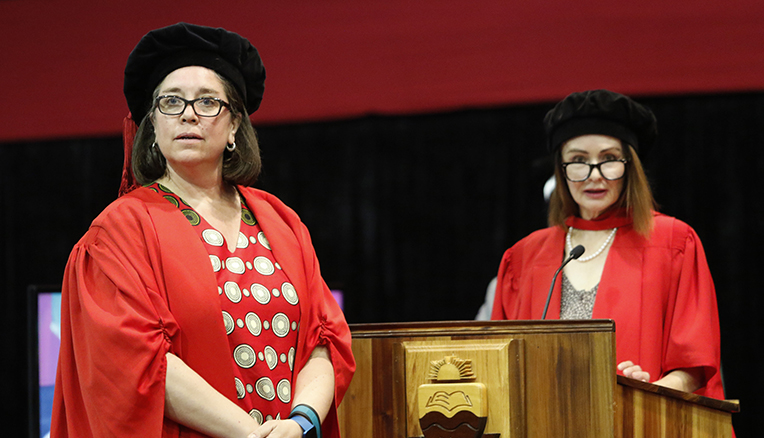Dr Thandi Lewin has spent the past six-and-a-half years of her life on her PhD. It was only in the final year of the process that the thesis came together. “I had a few chapters and had done literature reviews and some theoretical work, as well as a little initial analysis, but none of it actually added up to a coherent thesis. The moment when I realised that I actually did have a thesis was a great feeling and a huge relief because it was only then that the end was in sight,” she said.
On Wednesday 11 December 2019 her diligence culminated in a graduation ceremony at which she obtained her PhD in Higher Education Studies in the Faculty of Education at the University of the Free State (UFS). Dr Lewin formed a part of the pioneering cohort of the
South African Research Chairs Initiative (SARChI) Chair in Higher Education and Human Development Research Programme, under the leadership of
Professor Melanie WalkerThrough the twists and turns
Working on her thesis on Early career women academics: A case study of working lives in a gendered institution, Dr Lewin struggled with time constraints. “I could not work on it every night or every early morning like some people do. My job was demanding, so I worked most nights and often went to bed quite late. Hence, I failed to focus on it during the week,” she explained.
When she began her PhD her youngest child was one year old. In addition to her job becoming more and more challenging over the years, Dr Lewin also had to maintain a morning and evening routine in order to make the most of the limited time she and her family had together. Yet after all was said and done, her research still beckoned.
Reaching the stage of walking across the stage
Given the rigorous process of completing a PhD, one of the major motivators was her supervisor. “Prof Walker was loyal and never gave up on me. She was also pragmatic and understanding. The commitment from a supervisor who is considerate of your personal circumstances, but is also as dedicated to your research project as you are, is quite something to find.”
For much of the past three years of her doctorate, Dr Lewin’s father was ill. He eventually succumbed to his illness in January 2019. The graduate struggled with managing her emotions as she felt guilty about not spending enough time with him due to work and research. “Being a mum and a daughter meant that if I wasn’t at work or working on my PhD I was with my kids or with my dad. But I must also acknowledge that my partner, nanny, and part-time housekeeper provided critical support which I couldn’t have done without.”
On gender and organisational culturesThe Chief Director for Institutional Governance and Management support in the university education branch of the Department of Higher Education and Training found the experience garnered in the system-level of higher learning enormously helpful in her research process. “I have really enjoyed working in an area that interests me, and engaging with a topic that is policy-relevant,” she said.
 Melanie Walker (right) reading the PhD appraisal for Dr Thandi Lewin at the Graduation Ceremony.
Melanie Walker (right) reading the PhD appraisal for Dr Thandi Lewin at the Graduation Ceremony.
(Photo: Johan Roux)
Cultivating culture change
Enabling women to rise through the ranks would require more effort to improve gender equity. “Organisations and universities can never really achieve gender equity without fundamentally changing their structures and cultures, which are deeply gendered. This also cannot happen without social change, which needs to take place in broader society and not only within organisations,” said Dr Lewin.
What this means for society and organisations is a shift from focusing solely on individual women. According to Dr Lewin: “Universities, in addition to their inclination towards slow change, are also experienced by many as exclusionary – not just by women, but by people of colour and those from working-class backgrounds, and others who have been traditionally marginalised in higher education. This is a critical issue for South African higher education – it is going to take a lot of time and focused commitment to change the cultures of universities to be more inclusive.”